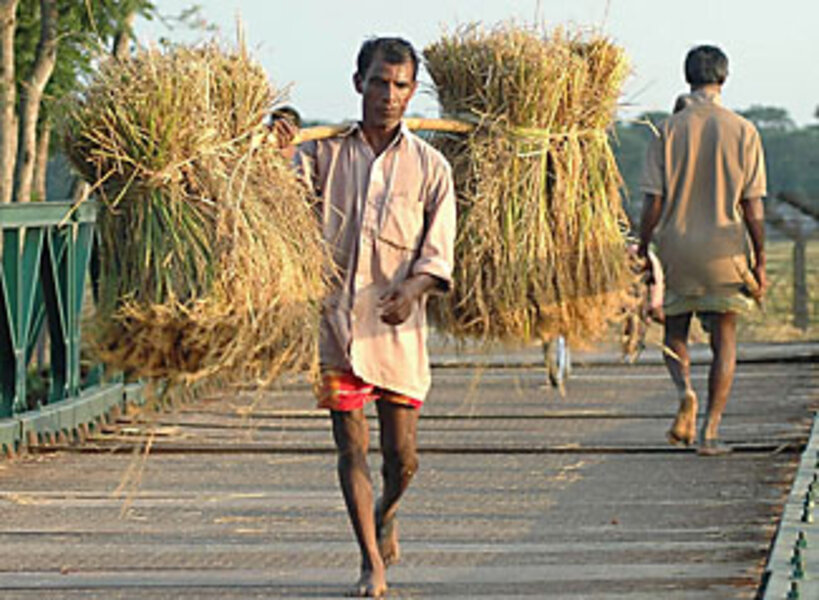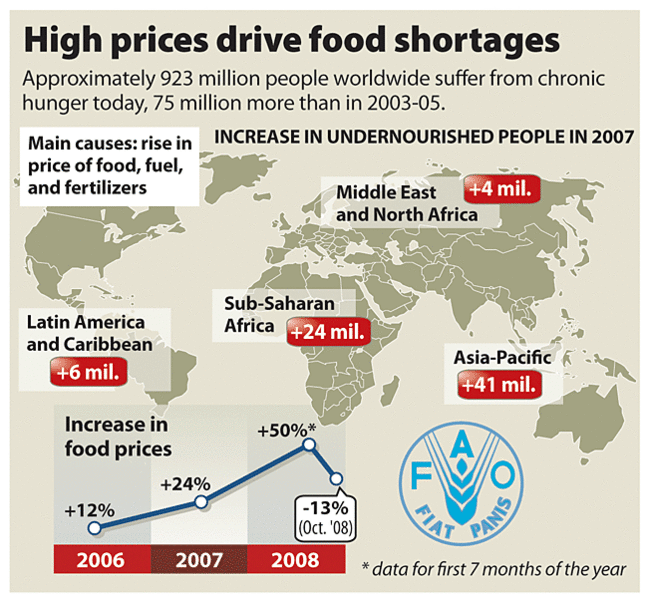Financial crisis may worsen food crunch it eclipsed
Loading...
| Phnom Penh, Cambodia
Call it crisis eclipse.
The global food crisis that dominated headlines earlier this year has been overshadowed by this fall's financial crisis, but it continues to exact a crippling toll on the world's poor. And, although commodity prices for a wide range of crops have fallen by as much as 50 percent from record highs in June, the financial crisis is expected to make it dramatically worse: credit for farmers could dry up, meaning less money to buy fertilizer and seed, leading in turn to greater global shortages of food.
Money for food aid could dry up as well. In June, governments and donors pledged $12.3 billion for the food crisis. So far, only $1 billion has actually been disbursed, as lending institutions and governments instead scramble to save ailing banks.
"My concern is that with the food crisis out of the headlines, policymakers will assume it's not a problem. Another worry is that, [with the financial crisis], there will simply be less money to invest in agriculture. We've got to turn that around," says Robert Zeigler, the director general of the International Rice Research Institute (IRRI) in the Philippines. (Editor's note: The original version misspelled Mr. Zeigler's name.)
Some factors contributing to the food crisis have ebbed, which adds to the notion that the worst is over.
The price of oil, needed to transport food to markets, has dropped from July highs of nearly $150 a barrel to around $50 today.
Corn, soybean, and wheat prices have fallen about 50 percent from record highs earlier in the year. And many of the restrictions set by grain-exporting governments like Vietnam, China and India – all of whom feared shortages and effectively hoarded grain supplies, causing prices to shoot up further – have now been eased, meaning supplies have stabilized and prices have come down accordingly.
Lower prices haven't ended crisis
Still, a country like Cambodia helps illustrate that lower prices have not ended the crisis. The price of rice – the country's staple food – has gone down by about 7 percent since August. But observers say that's not enough to offset the staggering 25 percent inflation of the last year.
"Workers already spend about 70 percent of their income on food. Prices have gone down, but they're still higher than other years. If you look at people's income versus inflation, many more are poor today," says Yang Saing Koma, president of the Cambodian Center for Study and Development of Agriculture, a think tank in the country's capital, Phnom Penh.
In fact, the Asian Development Bank estimates that 2 million more Cambodians may have been pushed into poverty.
The problem is playing out across the globe: food prices rose by 24 percent in 2007, pushing 75 million more people into chronic hunger, estimates the United Nations' Food and Agricultural Organization (FAO). In 2008, food prices surged again by 51 percent, meaning that millions more are likely to join the 923 million people already suffering from malnutrition. World food prices have come down by a modest 6 percent since September, the FAO estimates, but that can't reverse the damage already wreaking its way across the globe.
"Food prices are dropping, which is great, but its entirely too early to say that the food crisis is over," says Marcus Prior, a spokesman for the UN's World Food Program (WFP) in Nairobi, Kenya.
He points out that the food crisis is taking its greatest toll on sub-Saharan Africa, where 1 in 3 people were already estimated to be chronically hungry before the crisis. Last year, staggering food inflation added another 24 million people to the total of malnourished.
"We've seen people have to make decisions, taking their children out of school … so the children can help with work," says Mr. Prior, adding that Somalia, northern Kenya, northern Uganda and Ethiopia are among the hardest hit, because of conflict, drought, and successive harvest failures.
In Southern Africa, many subsistence farmers already suffer from high rates of HIV/AIDS. The food crisis has made them particularly vulnerable. "They can't produce as much because they're spending their resources on healthcare," says Richard Lee, a WFP spokesman in Zimbabwe.
Zimbabwe has emerged as a flashpoint, with the UN already feeding four million people there. Money is running out, and the UN fears a full-scale humanitarian crisis by January. "The problem in Zimbabwe is [lack of] access to any food," says Mr. Lee. "People in rural areas, some of them harvested nothing, some of them harvested very little. It's a very serious situation."
"The impact of the food crisis starts today," says Mr. Zeigler of IRRI. "If you consider a child under the age of 3, if they're malnourished for even three months, they're affected for a lifetime. It will affect an entire generation."
Financial crisis compounds woes
The financial crisis is now adding its own plague of threats.
Here in Cambodia, rice millers tend to borrow money from banks to pay farmers and to mill their rice. As banks seize up credit due to global recession fears, some mills are having trouble paying farmers, explains Mr. Koma.
Farmers in turn, after borrowing heavily for fertilizer, are operating at a loss.
For farmers elsewhere in the world, the financial crisis is creating a similarly sobering equation: it costs more money for them to grow, but they receive a lower price for their products at market – making growing food a risky venture.
"I could see some declines in production because of falling prices," says David Dawe, a senior economist at the FAO in Rome, adding that the credit crunch might also cut into production, although not as much as lower prices.
In Brazil, for example, production of corn may drop by 20 percent, while wheat production globally may drop by more than 4 percent, Bloomberg recently reported.
Solutions to the food crisis remain the same as before the financial crisis: massive investments are needed in agriculture and food aid programs. But now, it's more urgent.
The irony, experts say, is that many new grain technologies that can help expand food production are ready for implementation. But it will require money to get those technologies to farmers – money that may now be diverted to rescuing ailing banks.
"Research is a pipeline, and a lot of the products we've developed are ready and we have to get them out to farmers," says Zeigler. "It would be a shame for that not to happen."
Responses so far have resulted in governments restructuring finances to invigorate agricultural development and ease inflation. The African Development Bank recently augmented its agricultural portfolio by $1 billion, allocating a total of $4.8 billion. In Senegal, investments in agriculture will rise to $106 million, up from $58 last year. From Vietnam to Ethiopia, governments have slashed grain prices and fuel prices, and allocated money for school food programs.
Lending agencies have moved fast to disburse cash. The World Bank reports that, as of September, it had approved $83 million for 10 African countries, including money for school food programs and medical supplies.
Emergency food is being delivered, by the WFP and others. In Ethiopia, 6.6 million people are already beneficiaries of WFP food aid, and 2 million in Sudan. In Cambodia, school food programs, which were earlier cut back, have been resumed, targeting 250,000 children. In Afghanistan, nearly 200,000 metric tons of food are being delivered to assist 4.5 million people.
There is still a long way to go, experts warn. Some $20 billion will be needed to stave off the food crisis, the UN estimates. Money is coming in, but not fast enough. "Despite enthusiastic speeches and financial commitments, we have received only a tiny part of what was pledged," Jacques Diouf, the head of the UN food agency, said at a gathering for World Food Day in late October.






